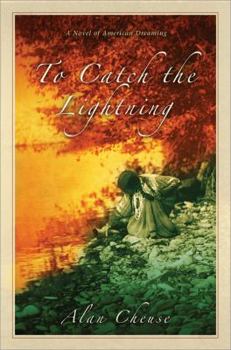To Catch the Lightning: A Novel of American Dreaming
Select Format
Select Condition 
Book Overview
A masterwork of American fiction. The story of a forgotten America, a bittersweet sepia-toned exploration of the intertwined plights of Edward Curtis, a real-life frontier photographer, and the... This description may be from another edition of this product.
Format:Hardcover
Language:English
ISBN:1402214049
ISBN13:9781402214042
Release Date:January 2008
Publisher:Sourcebooks Landmark
Length:502 Pages
Weight:1.85 lbs.
Dimensions:1.6" x 6.3" x 9.2"
Customer Reviews
2 ratings
American Dreamer
Published by Thriftbooks.com User , 15 years ago
When he began taking photographs of Native Americans in the Western United States in 1904, Edward Curtis could not have imagined that he was beginning the project that would last him for the rest of his working life. Curtis became so obsessed with making a complete pictorial record of Native American tribes that he found himself choosing the project over his family any time that the two came into conflict. Ultimately, he would lose his wife, his photography business, and most of his other assets because he allowed his photographs and the books he published to become the most important things in his life - everything else was secondary. In "To Catch the Lightning: A Novel of American Dreaming," Alan Cheuse uses longtime Curtis assistant William Myers and American Indian Jimmy Fly-wing to tell Edward Curtis's story. Myers served as translator and transcriber for Curtis, making it possible for the pair to record the ancient Indian legends, stories, songs and history that turned Curtis's project into so much more than just a collection of magnificent photographs. Fly-wing, a Plains Indian who out of curiosity climbed into the first train he ever saw and rode it all the way to Chicago, was an assistant of a different type, riding ahead of the party in order to locate Indian villages and build goodwill among the Indians about Curtis and his camera. Curtis's passion to visually record a society rapidly moving toward extinction was not well-rewarded during his lifetime despite the fact that much of his early work was financed by J.P. Morgan or that Teddy Roosevelt provided the forward for his series of books. After Morgan's death, whenever Curtis was not actually in the field, he fought to keep the project alive by raising whatever money he could in the big cities of the East, further limiting the time he could spend at home and greatly adding to his wife Clara's burden of raising their family and keeping their local photo studio in business entirely on her own. "To Catch the Lightning" has a dramatic story to tell but it tells that story unevenly. At times the narrative races along with an excitement and tension perfect for the life led by this American dreamer. At other times, particularly during the long dream sequences of Jimmy Fly-wing and Curtis himself, the pace becomes sluggish and somewhat confusing, causing the book to sputter a bit before it regains its rhythm. Despite its uneven pacing, however, "To Catch the Lightning" offers worthy insights and explanations to help explain a man so willing to forsake his wife and children for a dream, a dream that consumed his entire lifetime, and one for which he will long be remembered. Whether or not Curtis made the right choice for himself is certainly debatable. What is not debatable is that American history is richer and better documented because of the path he chose to follow.
From J. Kaye's Book Blog
Published by Thriftbooks.com User , 15 years ago
"To Catch the Lightning" by Alan Cheuse, is a sad, melancholic novel about passing. It's about the passing of the Indian way of life, the passing of a marriage, and the passing of a lifetime. It is about a man's destiny and his frailties and the effects on his family and the lives of people around him. It is about prophecy, signs, dreams and visions. Alan Cheuse explores the true life mission of Edward Curtis who photographed and documented the existing North American Indian tribes of 1900's. It was written in 3 points of view, Edward Curtis, William Meyers, his assistant who learned, translated, and wrote the traditions, and Jimmy fly-wing, a troubled Indian genius, part medicine man, part college educated. Cheuse writes in a literary style which paces the story through certain episodes during the decades that took Curtis to complete his work and his life. The settings allowed me to put what was happening in historical context. The descriptions of the tribes and ceremonies are true to life. What each man's hopes, dreams, and fears gave this novel a tragic flavor, like something from the early Greeks, but at the ending of the Old West frontier and the beginning of the modern era. I could not read this at one setting. I needed some time between settle down and reflect over what was happening. This novel made me ponder on some of my decisions and directions in life and what part the divine had in guiding me. This is a deep novel and worth the read.





